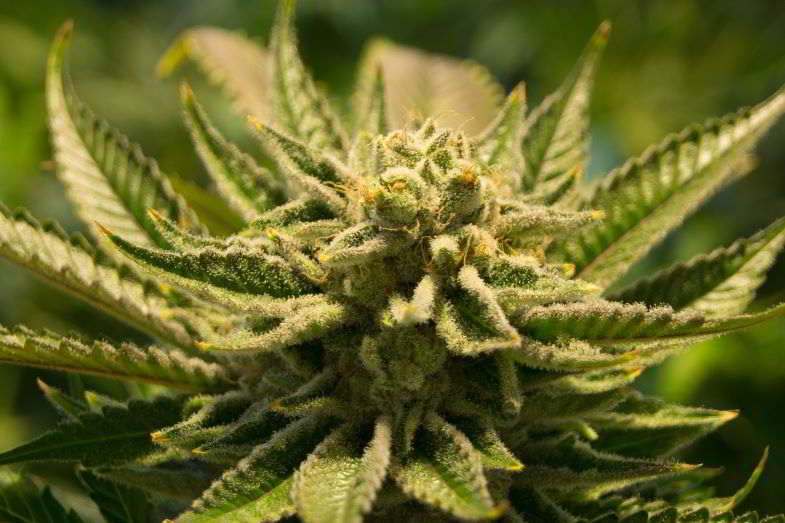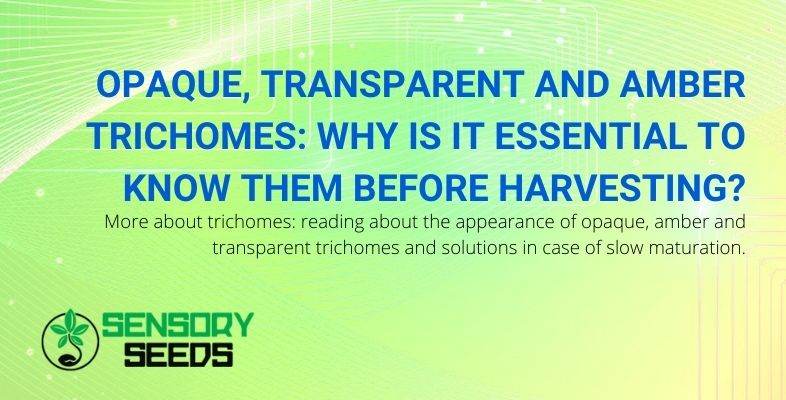Modified on: 07/09/2021
More about trichomes: reading about the appearance of opaque, amber and transparent trichomes and solutions in case of slow maturation.
To obtain good cannabis harvests, it is not enough to buy the best marijuana seeds, water them and wait for the plant to flower. It is essential to know the different stages and characteristics of the plant.
In this article, we want to talk about opaque, milky and amber trichomes.
Why is it important to consider them?
What are they used for?
Trichomes are lots of little mushroom-headed stalks (invisible to the naked eye) that are very useful for the plant’s health and provide critical information to canapiculturists in the pre-harvest phase.
Here is everything you need to know about trichomes.
What are trichomes? Here is how to recognize them and learn what they are used for.
When you hear about trichomes, terpenes, pistils and many other terms related to the cannabis world, it can be easy to get confused, but recognizing trichomes is easy.
What you need is a magnifying glass to point at the cannabis buds: trichomes are those many small stems characterized by the presence of a mushroom-shaped end.


Although the origin of the word trichome means ‘hairy growth’, it is essential not to confuse them with pistols, the tiny hairs seen with the naked eye on the flowering female hemp plant.
Trichomes are present in all varieties of cannabis plants, whether they come from fast growing weed seeds to auto-flowering or feminized seeds, and the reason is straightforward: they are essential.
If you are wondering why, it is essential to know about trichomes, there are many answers, but we will summarize them in two points:
- Trichomes are responsible for producing resin and cannabinoids, and recognizing their appearance (opaque, white or amber trichomes) allows cannabis growers to understand what kind of effects can be obtained from the plant’s inflorescences and when it is time to harvest them.
- Trichomes are essential for the survival of the hemp plant. Through resin production, they form a sticky coat that discourages attacks by pests, insects and herbivorous predators. Not only that, the resin protects marijuana plants from harmful UV rays and strong wind gusts.
Having clarified what trichomes are, it is now time to explain their role with cannabis growers.
Reading the trichomes growth: how do they give information to farmers?
Trichomes are an excellent communication tool between the canapiculturists and the plant. In particular, they signal when the time is right to harvest.
How? By their appearance and color.
Mostly it is possible to deal with trichomes:
- transparent;
- opaque;
- amber-colored;
- mixed.
Let us see the characteristics of the trichomes in each of these phases.
- Transparent trichomes.
When cannabis plants go through their first flowering phase, the first trichomes appear, which at this stage are not colored, but even transparent. When hemp growers are confronted with trichomes with these characteristics, they know that they are still immature, so harvesting would not make sense. - Opaque trichomes.
When the trichomes of hemp plants turn from transparent to opaque and white, they are maturing. At this stage, the resin produced already contains cannabinoids. Legal cannabis varieties usually develop high CBD levels, while illegal hemp varieties begin to make THC and terpenes with cerebral and energetic effects. Opaque trichomes last about two weeks, after which the plant continues to transform. Canapiculturists generally only harvest inflorescences at this stage if they have special requirements. Otherwise, they wait until the next step. - Amber trichomes.
When the trichomes turn from opaque to amber, the percentages of cannabinoids in the resin are still different. CBN usually prevails at this stage, but there may be differences from variety to variety. - Mixed trichomes.
When both amber and opaque white trichomes are present in the inflorescences, the cannabinoid percentages are well distributed, which is why many cannabis growers prefer this time of harvest.
It is essential to bear in mind that different hemp varieties take on other characteristics depending on the stage of maturity of their trichomes.
It means that before choosing cannabis seeds for your plantation, it is crucial to know what you want to achieve and then read the indications offered by the plant’s trichomes based on this.


What if the trichomes don’t ripe? Here’s what to consider.
When cannabis cultivation runs as smoothly as it should, the trichomes change color, as described above.
However, hemp growers sometimes have to deal with dull trichomes for more than two weeks … why?
The first cause is undoubtedly lack of light.
Sunlight or artificial light (in indoor cultivation) must be sufficient to promote growth; if it is not enough, the maturation of the plant slows down or stops, ruining the harvest.
However, if the lighting is correct, there may be other triggers for this problem.
Let’s see which ones:
- Irrigation.
When plants seem to have stunted growth, canapiculturists sometimes try to get them to react. One method is to decrease humidity, which will also be helpful to those wondering how to increase resin production. Decreasing the water supply suddenly makes the plant feel stressed and defensively speeds up the ripening of the trichomes from opaque to amber and resin production. - Temperature.
Changing the amount of heat to which hemp plants are exposed can also positively affect ripening. Some choose to increase the temperature by a few degrees and others to lower it, but the important thing is always staying between 21 and 26 degrees. - Fertilizers for flowering.
Lastly, you can also try supplementing your plants with a special fertilizer for the flowering period of hemp, preferably an organic and natural one.
Read also: What is ScrOG cultivation and what advantages does it offer?
To conclude.
Trichomes are the cannabis plant’s little messengers, whose appearance enables them to communicate with the hemp growers.
Transparent trichomes indicate that the inflorescences are still too young; opaque trichomes indicate that harvest time is approaching. Amber and mixed trichomes are the ideal time for most hemp growers.
After this in-depth study – wich is intended for information purposes only, reminding you that growing hemp is not allowed in most European countries, we invite you to check out our store Sensory seeds, where you can buy the best BSF seeds for collecting purposes.
Visit our store today on Sensoryseeds and buy marijuana seeds online!









